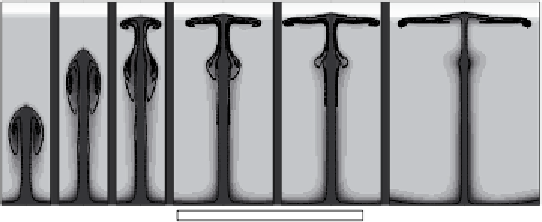Geology Reference
In-Depth Information
78 Ma
94 Ma
98 Ma
106 Ma
114 Ma
137 Ma
0
1
Temperature (
°
C)
Figure 7.15. Sequence from a numerical plume model including the effect of a
mantle in which ambient viscosity increases with depth. The viscosity steps up by
a factor of 20 at 700 km depth and has an exponential increase by another factor of
10 through the lower mantle. The plume speeds up as it enters the upper mantle,
and narrows as a result. (The effect of a phase transformation is also present in
this model, but is not significant here.)
could be explained by the model, in particular the concentration near the centres of
provinces of picrites, which are products of higher degrees of melting than basalts.
They argued that this can be explained by the temperature distribution of a plume
head, which is hottest at the central conduit and cooler to the sides (Figure 7.7).
A potential difficulty with this hypothesis was that the plume head might not
produce much melt if it rose under intact lithosphere, because this would keep it
below the depth of about 60 km at which the mantle begins to melt [72]. However,
Campbell
et al.
[73] pointed out that plumes are expected to melt more readily
than normal mantle, because their composition is more basalt-rich [74]. Numerical
models [75] showed that this substantially increases the amount of melting, though
there was still some deficit. Subsequent more detailed numerical modelling by
Leitch and Davies [76, 77] succeeded in accounting for the observed volumes of
flood basalts, and in the process found two other factors to be important.
First, the plume head must be grown from a thermal boundary layer. This is
because the hottest fluid, coming from the bottom of the thermal boundary layer,
flows up the axis and right to the top of the plume head (Figure 7.7).
Second, the vertical viscosity structure of the mantle has an important effect. The
upper mantle is 10-100 times less viscous than the lower mantle. This causes the
rising plume head to 'neck' down to a much narrower structure as it rises rapidly
through the upper mantle (Figure 7.15). It is then easier for the plume to displace
material laterally under the lithosphere, so it can penetrate to a shallower depth
compared with the plume in Figure 7.7. This considerably increases the amount of
melting in the top of the plume head. The result of the combined effects of plume
composition, internal thermal structure and rapid ascent through the upper mantle





